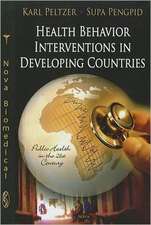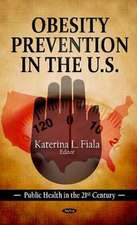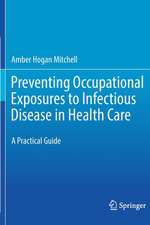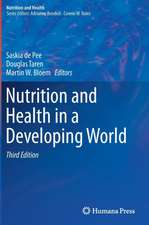Nutrition and Health in Developing Countries: Nutrition and Health
Editat de Richard David Semba Cuvânt înainte de P. Piot Editat de Martin W. Bloemen Limba Engleză Hardback – 23 iun 2008
| Toate formatele și edițiile | Preț | Express |
|---|---|---|
| Paperback (1) | 1458.49 lei 6-8 săpt. | |
| Humana Press Inc. – 23 aug 2016 | 1458.49 lei 6-8 săpt. | |
| Hardback (1) | 1466.00 lei 6-8 săpt. | |
| Humana Press Inc. – 23 iun 2008 | 1466.00 lei 6-8 săpt. |
Din seria Nutrition and Health
- 5%
 Preț: 1130.43 lei
Preț: 1130.43 lei - 5%
 Preț: 1006.13 lei
Preț: 1006.13 lei - 5%
 Preț: 1436.77 lei
Preț: 1436.77 lei - 5%
 Preț: 1134.09 lei
Preț: 1134.09 lei -
 Preț: 494.66 lei
Preț: 494.66 lei - 5%
 Preț: 932.05 lei
Preț: 932.05 lei - 5%
 Preț: 2153.61 lei
Preț: 2153.61 lei - 5%
 Preț: 1424.89 lei
Preț: 1424.89 lei - 5%
 Preț: 1615.25 lei
Preț: 1615.25 lei - 5%
 Preț: 1430.35 lei
Preț: 1430.35 lei - 5%
 Preț: 1118.73 lei
Preț: 1118.73 lei - 5%
 Preț: 1110.32 lei
Preț: 1110.32 lei - 5%
 Preț: 1434.18 lei
Preț: 1434.18 lei - 5%
 Preț: 1119.47 lei
Preț: 1119.47 lei - 5%
 Preț: 1552.10 lei
Preț: 1552.10 lei - 5%
 Preț: 1343.45 lei
Preț: 1343.45 lei - 5%
 Preț: 1123.13 lei
Preț: 1123.13 lei - 5%
 Preț: 803.75 lei
Preț: 803.75 lei - 5%
 Preț: 1108.72 lei
Preț: 1108.72 lei - 5%
 Preț: 1110.32 lei
Preț: 1110.32 lei - 5%
 Preț: 990.58 lei
Preț: 990.58 lei - 5%
 Preț: 1309.67 lei
Preț: 1309.67 lei - 5%
 Preț: 1425.61 lei
Preț: 1425.61 lei - 5%
 Preț: 1731.50 lei
Preț: 1731.50 lei - 5%
 Preț: 1056.95 lei
Preț: 1056.95 lei - 5%
 Preț: 1963.41 lei
Preț: 1963.41 lei - 5%
 Preț: 378.24 lei
Preț: 378.24 lei - 5%
 Preț: 1110.72 lei
Preț: 1110.72 lei - 5%
 Preț: 1426.71 lei
Preț: 1426.71 lei - 5%
 Preț: 1910.00 lei
Preț: 1910.00 lei - 5%
 Preț: 1110.32 lei
Preț: 1110.32 lei - 5%
 Preț: 1103.58 lei
Preț: 1103.58 lei - 5%
 Preț: 1439.50 lei
Preț: 1439.50 lei - 5%
 Preț: 1607.01 lei
Preț: 1607.01 lei - 5%
 Preț: 1321.41 lei
Preț: 1321.41 lei - 5%
 Preț: 1956.63 lei
Preț: 1956.63 lei - 5%
 Preț: 1618.70 lei
Preț: 1618.70 lei - 5%
 Preț: 1441.52 lei
Preț: 1441.52 lei - 5%
 Preț: 1123.13 lei
Preț: 1123.13 lei - 5%
 Preț: 720.84 lei
Preț: 720.84 lei
Preț: 1466.00 lei
Preț vechi: 1543.15 lei
-5% Nou
Puncte Express: 2199
Preț estimativ în valută:
280.56€ • 289.83$ • 233.49£
280.56€ • 289.83$ • 233.49£
Carte tipărită la comandă
Livrare economică 25 martie-08 aprilie
Preluare comenzi: 021 569.72.76
Specificații
ISBN-13: 9781934115244
ISBN-10: 193411524X
Pagini: 931
Ilustrații: XXIII, 934 p.
Dimensiuni: 178 x 254 x 58 mm
Greutate: 1.81 kg
Ediția:2nd ed. 2008
Editura: Humana Press Inc.
Colecția Humana
Seria Nutrition and Health
Locul publicării:Totowa, NJ, United States
ISBN-10: 193411524X
Pagini: 931
Ilustrații: XXIII, 934 p.
Dimensiuni: 178 x 254 x 58 mm
Greutate: 1.81 kg
Ediția:2nd ed. 2008
Editura: Humana Press Inc.
Colecția Humana
Seria Nutrition and Health
Locul publicării:Totowa, NJ, United States
Public țintă
ResearchCuprins
Nutrition and Development: A Historical Perspective.- Maternal Mortality in Developing Countries.- Low Birth Weight and Neonatal Mortality.- Infant Mortality.- Child Growth and Development.- Diarrheal Diseases.- Acute Lower Respiratory Infections.- Measles.- Malaria and Nutrition.- Tuberculosis.- Human Immunodeficiency Virus Infection.- Malnutrition.- Vitamin A Deficiency.- Nutritional Rickets and Vitamin D Deficiency.- Zinc Deficiency.- Iron Deficiency and Anemia.- Iodine Deficiency Disorders.- Multiple Micronutrient Malnutrition.- Nutrition in the Elderly in Developing Countries.- The Nutrition Transition and Its Relationship to Demographic Change.- The Rapid Emergence of Obesity in Developing Countries.- Rapid Urbanization and the Challenges of Obtaining Food and Nutrition Security.- Impact of Parental Tobacco Use on Child Malnutrition and Survival.- Humanitarian Emergencies.- Tackling Nutrient Deficiencies and Life-Threatening Disease.- The Indian Ocean Tsunami of December 26, 2004.- The Impact of Supermarkets on Farmers, Consumers, and Food Security in Developing Countries.- Homestead Food Production for Improving Nutritional Status and Health.- Food Policy.- Need, Efficacy, and Effectiveness of Multiple Vitamin/Mineral Supplements for Young Children and Considerations for Programs.- How Much Do Data Influence Programs for Health and Nutrition?.- The Economics of Nutritional Interventions.- Ethics in Public Health Research.- Beyond Partial Analysis.
Recenzii
From the reviews of the second edition:
“Like the first edition, the second edition of Nutrition and Health in Developing Countries- a tome to which no less than 45 leading minds in a diverse range of disciplines have contributed - is set to define a new level of understanding in this important area of policy, research and programming. Intended for policy makers, nutritionists, students, scientists and professionals, the book provides the most recent and up-to-date knowledge regarding major health and nutritional problems in developing countries, presented to facilitate an integrated approach to health research, programs, and policy. New chapters in the book's final section contain special topics relating to humanitarian emergencies, including a case study of the Indian Ocean tsunami in 2004, food in humanitarian relief, food policy, the emerging role of supermarkets in developing countries, homestead food production, aging, ethics, and the adverse impact of parental tobacco use on child health in poor families. As readers of the previous edition know, what is characteristic of the volume is its underlying conviction that global health and nutrition problems can only be solved through a more integrated, multidisciplinary approach to better understand the various levels of causality and interactions between determinants. The book powers on with insightful contributions from academics and professionals steeped in the fields of clinical nutrition, medicine, immunology, infectious disease, epidemiology, public health nutrition, anthropology, health policy, economics, and disaster planning.” (Sight and Life)
“This second edition is updated and enlarged with 12 more chapters than the 2001 edition (32 total). Each chapter is a critical literature review considering current research, conclusions, and needed research. Conflicting results of studies are included. Chapters cover both specific diseases such as measles, malaria, andtuberculosis; and dietary deficiencies such as vitamin A or zinc. Contributors also address more problem-specific areas such as infant mortality, food policy, and ethics. The chapter on the 2004 Indian Ocean tsunami provides a study in what is needed, and not needed, in response to disasters. Chapter authors are an international selection of people working in the field of nutrition and health. Chapter citation listings (several numbering over 200 citations) demonstrate the extent of coverage for each subject. Although each chapter can stand alone, those who read the whole volume will get a very comprehensive overview of nutrition-related health problems in developing countries. Summing Up: Recommended. Upper-level undergraduates through professionals/practitioners.” (N. Duran, Texas A&M University in CHOICE, January 2009)
"This is the second edition of a comprehensive account of the issues of nutrition and health in the developing world … . The tables and figures are generally helpful in supporting the text … . This is a useful book for many working across disciplines that bridge nutrition and health within the context of developing countries. … will help program developers and policy makers." (Noel Chavez, Doody’s Review Service, January, 2009)
"This is an excellent comprehensive and authoritative multidisciplinary treatment of a subject of overwhelming importance in today's developing countries...The purposeful overlap between these chapters on specific disease and health problems and subsequent chapters on nutritional deficiencies in the third section of the book is to be highly commended, because the epidemiology and consequences of nutrition and infection are inseparable; they interact synergistically in almost all circumstances...Great advances have been made in the understanding of micronutrient malnutrition in the last three decades, its multiple nature, and the interactions among nutrients. It is now evident thatmicronutrient deficiencies usually occur together and require an integrated and multidisciplinary approach. This book will help not only nutritionists but also other health specialists understand and take these issues into consideration when developing policies and interventions. This book will provide policymakers and nutrition and health professionals with the most recent and up to date knowledge regarding major health and nutrition problems in developing countries. Its editors and authors are all outstanding international authorities and the text is greatly expanded in this new edition." (Food and Nutrition Bulletin, vol. 30, no. 1 © 2009, The United Nations University)
“Like the first edition, the second edition of Nutrition and Health in Developing Countries- a tome to which no less than 45 leading minds in a diverse range of disciplines have contributed - is set to define a new level of understanding in this important area of policy, research and programming. Intended for policy makers, nutritionists, students, scientists and professionals, the book provides the most recent and up-to-date knowledge regarding major health and nutritional problems in developing countries, presented to facilitate an integrated approach to health research, programs, and policy. New chapters in the book's final section contain special topics relating to humanitarian emergencies, including a case study of the Indian Ocean tsunami in 2004, food in humanitarian relief, food policy, the emerging role of supermarkets in developing countries, homestead food production, aging, ethics, and the adverse impact of parental tobacco use on child health in poor families. As readers of the previous edition know, what is characteristic of the volume is its underlying conviction that global health and nutrition problems can only be solved through a more integrated, multidisciplinary approach to better understand the various levels of causality and interactions between determinants. The book powers on with insightful contributions from academics and professionals steeped in the fields of clinical nutrition, medicine, immunology, infectious disease, epidemiology, public health nutrition, anthropology, health policy, economics, and disaster planning.” (Sight and Life)
“This second edition is updated and enlarged with 12 more chapters than the 2001 edition (32 total). Each chapter is a critical literature review considering current research, conclusions, and needed research. Conflicting results of studies are included. Chapters cover both specific diseases such as measles, malaria, andtuberculosis; and dietary deficiencies such as vitamin A or zinc. Contributors also address more problem-specific areas such as infant mortality, food policy, and ethics. The chapter on the 2004 Indian Ocean tsunami provides a study in what is needed, and not needed, in response to disasters. Chapter authors are an international selection of people working in the field of nutrition and health. Chapter citation listings (several numbering over 200 citations) demonstrate the extent of coverage for each subject. Although each chapter can stand alone, those who read the whole volume will get a very comprehensive overview of nutrition-related health problems in developing countries. Summing Up: Recommended. Upper-level undergraduates through professionals/practitioners.” (N. Duran, Texas A&M University in CHOICE, January 2009)
"This is the second edition of a comprehensive account of the issues of nutrition and health in the developing world … . The tables and figures are generally helpful in supporting the text … . This is a useful book for many working across disciplines that bridge nutrition and health within the context of developing countries. … will help program developers and policy makers." (Noel Chavez, Doody’s Review Service, January, 2009)
"This is an excellent comprehensive and authoritative multidisciplinary treatment of a subject of overwhelming importance in today's developing countries...The purposeful overlap between these chapters on specific disease and health problems and subsequent chapters on nutritional deficiencies in the third section of the book is to be highly commended, because the epidemiology and consequences of nutrition and infection are inseparable; they interact synergistically in almost all circumstances...Great advances have been made in the understanding of micronutrient malnutrition in the last three decades, its multiple nature, and the interactions among nutrients. It is now evident thatmicronutrient deficiencies usually occur together and require an integrated and multidisciplinary approach. This book will help not only nutritionists but also other health specialists understand and take these issues into consideration when developing policies and interventions. This book will provide policymakers and nutrition and health professionals with the most recent and up to date knowledge regarding major health and nutrition problems in developing countries. Its editors and authors are all outstanding international authorities and the text is greatly expanded in this new edition." (Food and Nutrition Bulletin, vol. 30, no. 1 © 2009, The United Nations University)
Textul de pe ultima copertă
Nutrition and Health in Developing Countries, Second Edition was written with the underlying conviction that global health and nutrition problems can only be solved through a firm understanding of the different levels of causality and the interactions between the various determinants. This volume provides policy makers, nutritionists, students, scientists, and professionals with the most recent and up-to-date knowledge regarding major health and nutritional problems in developing countries. This greatly expanded second edition has new chapters relevant to humanitarian emergencies, including a case study of the Indian Ocean tsunami in 2004, food in humanitarian relief, food policy, the emerging role of supermarkets in developing countries, homestead food production, aging, ethics, and the adverse impact of parental tobacco use on child health in poor families. These new chapters reflect the increasing complexity and changes that are occurring in developing countries. Nutrition and Health in Developing Countries, Second Edition, brings together a group of authors who come from diverse backgrounds of clinical nutrition, medicine, immunology, infectious disease, epidemiology, public health nutrition, anthropology, health policy, economics, and disaster planning. This book will stimulate further thought, comprehensive and effective policies and programs, and research across disciplines in the goal of improving health and nutrition in developing countries in order to reach the Millennium Goals by the year 2015.
Caracteristici
Greatly expanded from the First Edition New chapters relevant to humanitarian emergencies for policy makers, nutritionists, scientists, students Includes supplementary material: sn.pub/extras





















![Traite D'Hygiene Publique Et Privee. [2]](https://i4.books-express.ro/bt/9782012773240/traite-d-hygiene-publique-et-privee-2.jpg)




